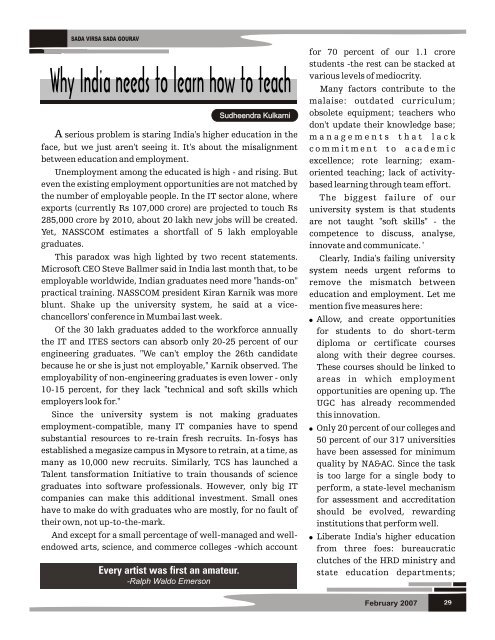PASE WISE FEB 07 - Guru Gobind Singh Study Circle
PASE WISE FEB 07 - Guru Gobind Singh Study Circle
PASE WISE FEB 07 - Guru Gobind Singh Study Circle
You also want an ePaper? Increase the reach of your titles
YUMPU automatically turns print PDFs into web optimized ePapers that Google loves.
Why India needs to learn how to teach<br />
A serious problem is staring India's higher education in the<br />
face, but we just aren't seeing it. It's about the misalignment<br />
between education and employment.<br />
Unemployment among the educated is high - and rising. But<br />
even the existing employment opportunities are not matched by<br />
the number of employable people. In the IT sector alone, where<br />
exports (currently Rs 1<strong>07</strong>,000 crore) are projected to touch Rs<br />
285,000 crore by 2010, about 20 lakh new jobs will be created.<br />
Yet, NASSCOM estimates a shortfall of 5 lakh employable<br />
graduates.<br />
This paradox was high lighted by two recent statements.<br />
Microsoft CEO Steve Ballmer said in India last month that, to be<br />
employable worldwide, Indian graduates need more "hands-on"<br />
practical training. NASSCOM president Kiran Karnik was more<br />
blunt. Shake up the university system, he said at a vicechancellors'<br />
conference in Mumbai last week.<br />
Of the 30 lakh graduates added to the workforce annually<br />
the IT and ITES sectors can absorb only 20-25 percent of our<br />
engineering graduates. "We can't employ the 26th candidate<br />
because he or she is just not employable," Karnik observed. The<br />
employability of non-engineering graduates is even lower - only<br />
10-15 percent, for they lack "technical and soft skills which<br />
employers look for."<br />
Since the university system is not making graduates<br />
employment-compatible, many IT companies have to spend<br />
substantial resources to re-train fresh recruits. In-fosys has<br />
established a megasize campus in Mysore to retrain, at a time, as<br />
many as 10,000 new recruits. Similarly, TCS has launched a<br />
Talent tansformation Initiative to train thousands of science<br />
graduates into software professionals. However, only big IT<br />
companies can make this additional investment. Small ones<br />
have to make do with graduates who are mostly, for no fault of<br />
their own, not up-to-the-mark.<br />
And except for a small percentage of well-managed and wellendowed<br />
arts, science, and commerce colleges -which account<br />
Every artist was first an amateur.<br />
Sudheendra Kulkarni<br />
-Ralph Waldo Emerson-Henry David Thoreau<br />
for 70 percent of our 1.1 crore<br />
students -the rest can be stacked at<br />
various levels of mediocrity.<br />
Many factors contribute to the<br />
malaise: outdated curriculum;<br />
obsolete equipment; teachers who<br />
don't update their knowledge base;<br />
managements that lack<br />
commitment to academic<br />
excellence; rote learning; examoriented<br />
teaching; lack of activitybased<br />
learning through team effort.<br />
The biggest failure of our<br />
university system is that students<br />
are not taught "soft skills" - the<br />
competence to discuss, analyse,<br />
innovate and communicate. '<br />
Clearly, India's failing university<br />
system needs urgent reforms to<br />
remove the mismatch between<br />
education and employment. Let me<br />
mention five measures here:<br />
Allow, and create opportunities<br />
for students to do short-term<br />
diploma or certificate courses<br />
along with their degree courses.<br />
These courses should be linked to<br />
areas in which employment<br />
opportunities are opening up. The<br />
UGC has already recommended<br />
this innovation.<br />
Only 20 percent of our colleges and<br />
50 percent of our 317 universities<br />
have been assessed for minimum<br />
quality by NA&AC. Since the task<br />
is too large for a single body to<br />
perform, a state-level mechanism<br />
for assessment and accreditation<br />
should be evolved, rewarding<br />
institutions that perform well.<br />
Liberate India's higher education<br />
from three foes: bureaucratic<br />
clutches of the HRD ministry and<br />
state education departments;<br />
February 20<strong>07</strong><br />
29











![ikau ibsrY pRBu mnY qy ijs ky gux eyh]](https://img.yumpu.com/43104272/1/190x245/ikau-ibsry-prbu-mny-qy-ijs-ky-gux-eyh.jpg?quality=85)




